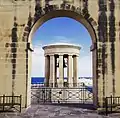Monopteros
A monopteros (Ancient Greek: ὁ μονόπτερος, from: μόνος, 'only, single, alone', and τὸ πτερόν, 'wing') is a circular colonnade supporting a roof but without any walls.[1] Unlike a tholos (in its wider sense as a circular building), it does not have walls making a cella or room inside. In Greek and especially Roman antiquity, the term could also be used for a tholos. In ancient times, monopteroi (Ancient Greek: οἱ μονόπτεροι) served among other things as a form of baldachin for a cult image. An example of this is the Monument of Lysicrates in Athens, albeit with the spaces between the columns being walled in, even in ancient times. The Temple of Rome and Augustus on the Athenian Acropolis is a monopteros from Roman times, with open spaces between the columns. Cyriacus of Ancona, a 15th-century traveller, handed down his architrave inscription: Ad praefatae Palladis Templi vestibulum.

A monopteros (or monopteron) is also known as cyclostyle (from the Greek words for "circle" and "column").[2] The adjectives are monopteral and cyclostylar.
In Baroque and Neoclassical architecture, a monopteros as a pavilion, often given a classical name such as a "muses' temple" is a popular garden feature in English and French gardens. The monopteros also occurs in German parks, as in the English Garden in Munich and in Hayns Park in Hamburg-Eppendorf. Many wells in parks and spa centres are covered by a monopteros. Many monopteroi have staffage structures like a porticus placed in front of the monopteros. These also have only a decorative function, because they are not needed in order to provide an entrance to a temple that is open on all sides.
Many monopteroi are described as rotundas due to their circular floor plan. The tholos also goes by that name. However, many monopteroi have square or polygonal plans, and these would not be described as rotundas. An example is the Muses' Temple with the muse, Polyhymnia, in the grounds of Tiefurt House, that has a hexagonal floor plan.
Examples
 The pavilion in the Court Garden of the New Palace, Bayreuth
The pavilion in the Court Garden of the New Palace, Bayreuth.jpg.webp) The monopteros in the English Garden, Munich
The monopteros in the English Garden, Munich The Apollo Temple in the Nymphenburg Castle Park, Munich
The Apollo Temple in the Nymphenburg Castle Park, Munich The Venus Temple at the Linderhof Palace, Bavaria, Germany
The Venus Temple at the Linderhof Palace, Bavaria, Germany The Leibniz Temple in the Georgengarten, Hanover
The Leibniz Temple in the Georgengarten, Hanover Well temple in the spa park at Bad Vilbel
Well temple in the spa park at Bad Vilbel Monopteros in the castle park at Eutin Castle (by C.F. Hansen, 1796)
Monopteros in the castle park at Eutin Castle (by C.F. Hansen, 1796) Venus Temple in the Wörlitzer Park
Venus Temple in the Wörlitzer Park The Breakfast Pavilion (Frühstückspavillon) in Kassel
The Breakfast Pavilion (Frühstückspavillon) in Kassel The Siege Bell Memorial in Valletta
The Siege Bell Memorial in Valletta
See also
- Belvedere (structure)
- Eyecatchers
- Gazebo
- Aedicule: often not free-standing
- Baldachin (canopy)
- Ciborium (canopy)
- Cupola on top of a dome
References
- Curl, James Stevens (2006). Oxford Dictionary of Architecture and Landscape Architecture, 2nd ed., OUP, Oxford and New York, p. 500. ISBN 978-0-19-860678-9.
- "A structure composed of a circular range of columns without a core"
Literature
- Wolfgang Binder: Der Roma-Augustus Monopteros auf der Akropolis in Athen und sein typologischer Ort. Karlsruhe 1969.
- Ingrid Weibezahn: Geschichte und Funktion des Monopteros. Untersuchungen zu einem Gebäudetyp des Spätbarock und des Klassizismus. Hildesheim 1975, ISBN 3-487-05764-6. Online: (Google Books)
External links
This article incorporates text from a publication now in the public domain: Chisholm, Hugh, ed. (1911). "Cyclostyle". Encyclopædia Britannica. Vol. 7 (11th ed.). Cambridge University Press. p. 689.